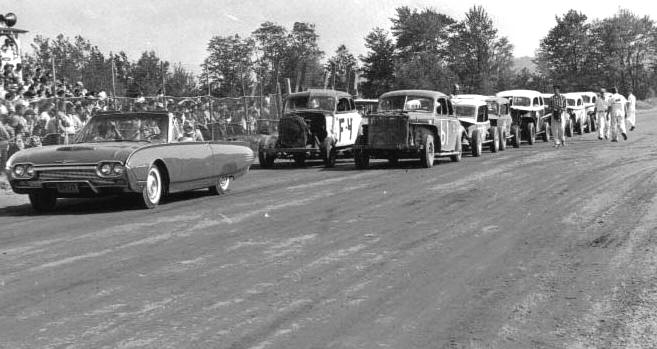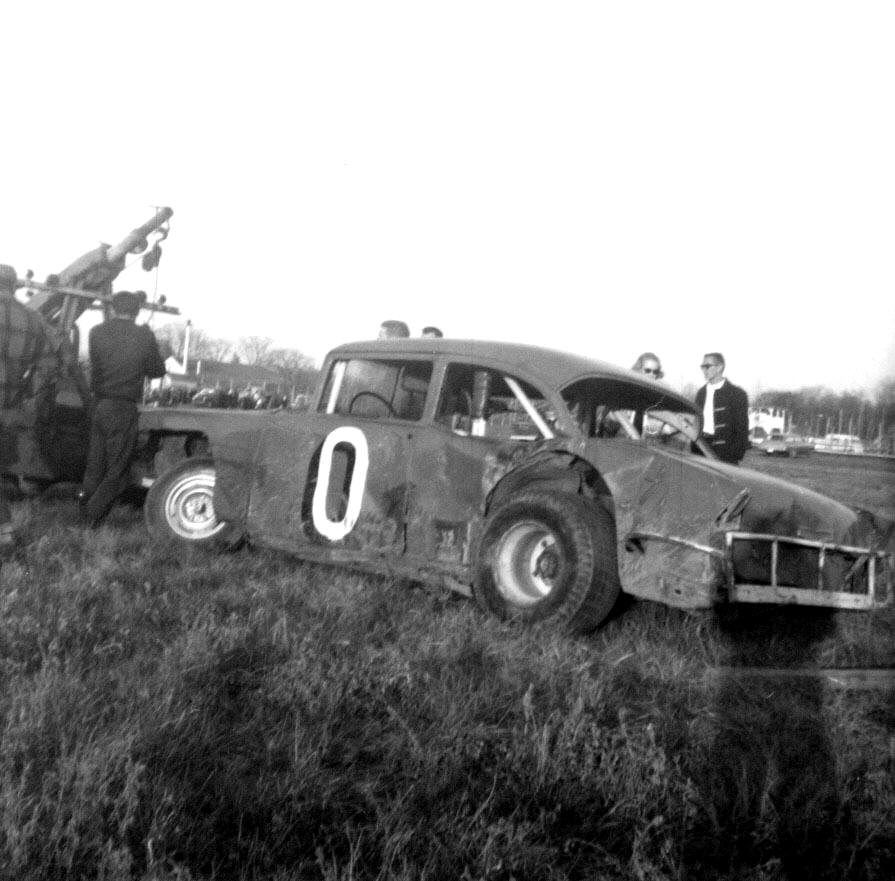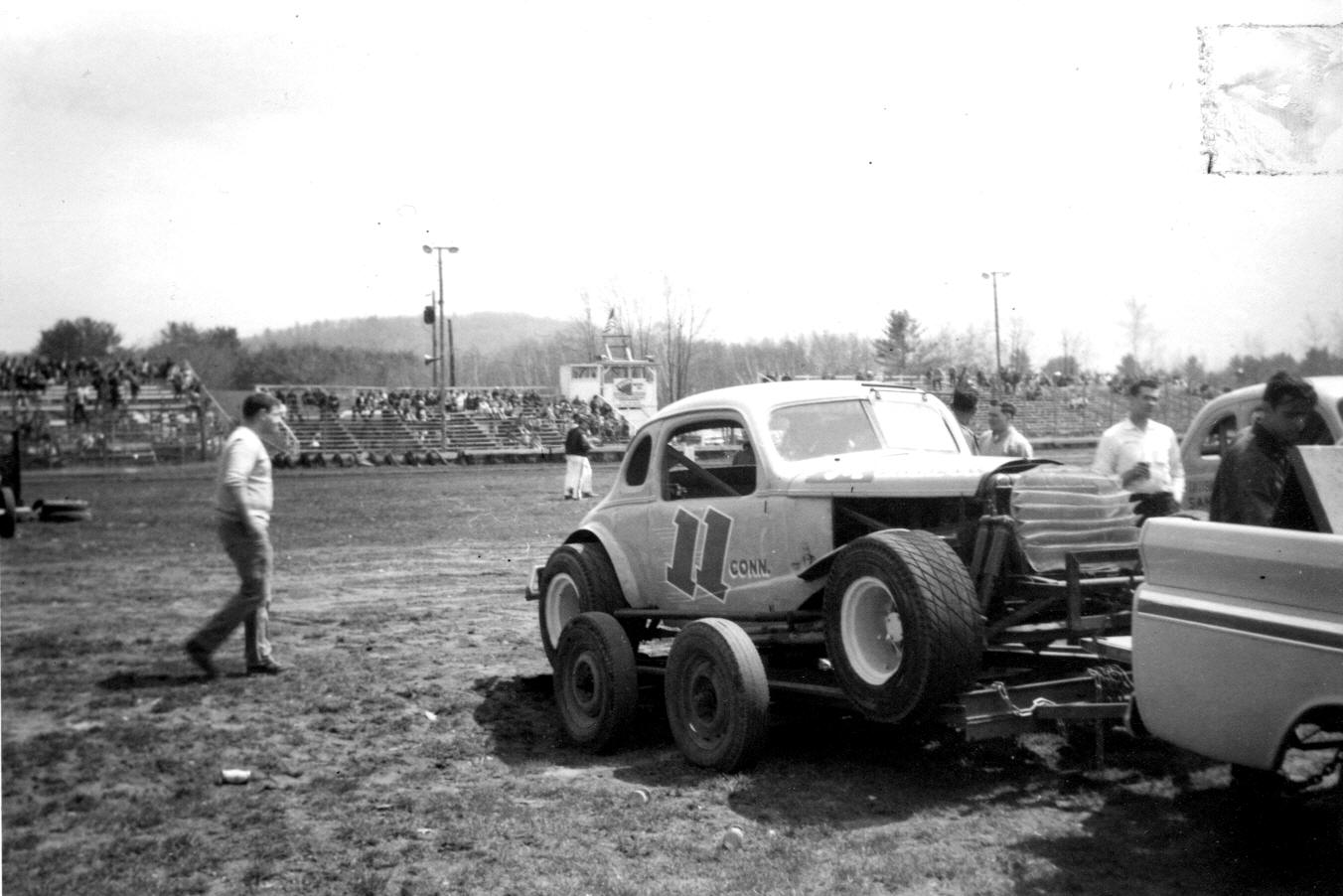BILL'S SOMEWHAT WEEKLY BLOG
|
|
Since I seem to have lost my forum, Mark
Thomas' "Racin' Paper", I will apparently enter the 21st Century and start doing
my column as a
blog. In certain times of the year, this may not be weekly; but I promise to
keep it regular. Many of the site regulars have only been able to
get my columns via this site, anyway, and representing the very newspaper that
was given out at Thunder Road gave me no press courtesies.
So, I might as well do it this way and reach some different readers. Let me know
what you think. -Bill
Week of September 30, 2012
|
|
ONE PICTURE CAN TELL A WHOLE STORY
The Howard
Stevens photo speaks volumes. [Bob Frazier Photo via Mike Richards]
It’s a highly clichéd statement; but still true: a picture can say a thousand words. In this case, a picture can speak volumes about where a race track might be headed. A 1964 photo of Howard Stevens, a Claremont, NH driver running for a Rutland, VT car owner, shows him receiving the checkers from starter, Danny Rumpf. The photo tells a lot, in hindsight. The weathered bleachers in the background feature a hastily - built, unpainted sort of temporary press box / photographers' stand. The Stevens car, itself, would come back in the next season totally transformed into an overhead V-8 sportsman - style entry,

It is getting dusky,
and the Corey crew is loading Pete’s trend – setting Falcon onto what served
to be a state – of – the – art trailer in those days: 1964. [Ladabouche
Collection] Below- The Corey crew rides in, very conscious of the stir that
was created around the Falcon’s unexpected arrival at Fairmont. [Courtesy of
Ted Vogel, Sr.]

There is another photo from almost exactly the same time and place. The second one, in this case, happens to one of several I have from the 1964 visit of Fonda Speedway star Pete Corey, a man whose exploits wee roundly discussed even in rural Vermont. Also, a younger Corey had down some limited racing at the old Fairmont Park Motor Speedway in the early 1950’s. Between the fact that it was Corey and his – breaking Falcon – bodied sportsman, and the fact that it was the last race of the year, the visit had caused quite a stir. I don’t recall his winning that day, however.

The new Ford
Thunderbird of Bob Hoffer, one of the Fairmont drivers, paces the first
feature at CJ Richards’ Fairmont Speedway on Memorial Day, 1962. Note how many
of the spectators had to stand by the fence. Hoffer would be killed in that
car in Canada in 1964. Beryl Fitzgerald’s F4 would be terminated in a huge
pileup at the Rutland Fair in the Fall. [Courtesy of the Hoffer Family]
Again, the photo tells a number of stories. The deserted bleachers are very rustic, and a hastily – built, unpainted building above them appears to be some sort of press box or photographers’ room that had been added on next to the venerable old announcer’s stand [unchanged since the Fairmont track of 1951 save for the fact it had been moved from the infield to above the bleachers]. The bleakness of the infrastructure speaks to the fact that the owner [in this case C. J. Richards] either did not have enough revenue generated from his shows or that – perhaps more accurately – this was not a permanent venue for him.
This shot shows Roger
Gauthier [helmet under arm], Dutch Reed [90A jacket], car owner Tony Villano,
Sr, [by Gauthier] and Tony, Jr. - at Fairmont -on an October afternoon at
Fairmont Speedway in 1964. Jeep Herbert usually the 37NY at Fonda that year.
[Ladabouche Photo]
If you can make out what is behind and beyond the stands, to the east, you can make out Tony Villano’s unique little cab-over Ford Falcon pickup, hauling his yellow #37 – Corey’s ride from 1962. Villano had brought in his 1937 Ford sportsman that had replaced his well – used 1936 Chevy that had nearly won a track championship at Fonda. That day, he was using Roger Gauthier, a veteran driver from Hartford, NY who split time between Fonda and Fairmont.
That last race at Fairmont Speedway, that October Sunday afternoon, had drawn a few Fonda cars, much to the interest and delight of the locals. Corey may have brought one or two other Fonda cars with him that day, but I cannot recall. I do know that, in addition to Gauthier and Corey, Dutch Reed, another driver similar to Gauthier, was around the Villano car.
Ray Sitterly, a second
– level Fonda driver, was the first to arrive at Fairmont Speedway with a New
York
style sportsman car – in 1963. [Ladabouche Photo]
The years before that, such Fonda teams as Bill Fowler’s 27Jr, with Jollie Ollie Palmer aboard; Villano’s older coupe, with journeyman Wayne Coon subbing for Corey; Allie Swears’ ageless red and white #51, with the driver du jour being Nelson Moore that day; Roger Gauthier, a Fairmont regular, had come in with Charles Habreck’s snazzy red #53NY; Amsterdam’s Ray Sitterly; and rising star Peppy Peppecelli all had visited the track which ordinarily did not allow overhead V-8 sportsman cars to come in and run roughshod over their sixes and flatheads. Even Connecticut sportsman cars, such as Jim Koehler and Bill Hodges had made trips to Fair Haven VT.

Sometime - Fairmont
regular Roger Gauthier did not win a feature at either Fairmont or Fonda with
Charles Habreck’s spiffy red sportsman; but he won a special feature at
Victoria with it. [Courtesy of Bob Novak]
Richards had staged a few “special” races in his time at Fairmont. One particular season, he ended the racing at the track with an open race that attracted the great Steve Danish, as well as Jean – Guy Chartrand, from Canada, and a few of the smaller Fonda teams. Chartrand was running away with the 100 lapper when his rear end blew on lap 98 – handing the race to Danish. It was one of the great Danish’s last in a career of hundreds of wins. CJ also had a few “opens” that attracted the likes of his friend, Will Cagle, as well as Pee Wee Griffin, Ken Shoemaker, Ron Narducci, and more.
The cars of Pete Corey, Ken Shoemaker, Ron Narducci, and Harold Montayne are
visible as the all – star
cars line up for a special Fairmont feature. [Courtesy of Ed Fabian]
It is likely C.J. had declared some sort of “open rules” to attract the New York teams for what was supposed to be “regular” season enders - before they tore the cars down or put them in mothballs for the year. It is also likely that he took close notice of the strong interest the crowds had in these sportsman cars. A few Lebanon Valley cars with V-8’s had come and gone in the interim. John Ryan had brought in a late model – bodied overhead V-9 Valley sportsman, and drivers such as Stan Wetmore and Lou Searing had come, as well. Locals were beginning to come out with V-8’s: Warrensburg’s Dick Pennock had one such coupe built. Knowing Richards, those wheels were turning.

When
Valley runner John Ryan brought his late model – bodied sportsman to Fairmont
in October of 1964, the CVRA officials found no fault; but the rough track
broke his suspension. [Ladabouche Photo]
When the 1965 season rolled around, the CVRA rules now were completely open to the overhead V-8 sportsman. In fact, it appeared as though one ought to have an overhead in order to be on any kind of equal footing with the competition. The Corey photo had, in deed, offered clues to what was to come at C. J. Richards’ Champlain Valley Racing Association programs.
Ironically, it was Richards who had – at the same time - done a small bit to reduce the existence of the overhead V-8 sportsman car in Vermont. In 1961, when Hi Monroe and Lee Tucker opened Otter Creek Speedway, at Monroe’s farm in Waltham, they had the foresight to grab a NASCAR sanction. This had regularly brought in anywhere from a handful, to several overhead cars in any given program at the bumpy, dusty, long dirt oval near Vergennes.
The 7VT, a Vermont –
built NASCAR sportsman, was one of the many such overheads that ran at Otter
Creek Speedway in 1961. By 1963, they were gone. This team, then with driver
Dutch Reed and later, with Jack DuBrul, ended up running faraway Fonda and
Victoria Speedways. [Courtesy of Cho Lee]
Richards began to become involved in the track increasingly and – by 1963 – he was running it . While having a couple of special overhead shows, he had run NASCAR out and put in his CVRA running rules [which did not allow for overhead V-8’s]. The few sportsman shows were successful, usually won by Ken Shoemaker, but the track was idle throughout the entire 1964 season – that pivotal year of the Corey Falcon.
When the 1965 season opened, with many of the CVRA teams arriving with overhead sportsman cars, Otter Creek was supposedly opened under the promotion of former CVRA race driver “Little Joe” D’Avignon, of Cornwall. Richards insists that he was still behind the operation, which was now going by Hillside Raceway. The track saw the same CVRA sportsman cars as did Fairmont [which was enjoying a resurgence of interest that year]; but, none of the old sportsman cars from the early two years of the Waltham track were regulars.

Connecticut
NASCAR regular Jim Koehler began running Fairmont and Hillside Raceway in
1965, before destroying the beautiful 11CT at Fonda. The background of this
shot shows more stands and a little new paint; but nothing much was added to
Fairmont despite the successful season. [Ladabouche Photo]
Richards’ Saturday night shows at Fairmont were going very well. More and more, the fields were predominantly overheads. At the very beginning of that season, a number of the former banner teams from the track’s flathead days tried running their flathead cars against their peers who had made the change and against the many new teams which were now coming in to run under the new rules. The former Vermont State Champion team of Frank “Stroker” Smith, from Keene, NH and his driver Moran “Sonny” Rabideau of Brattleboro, VT were the most successful. Rabideau and his black and white cutdown, the 311, would lead many of the features; but, the strain of the gear they had to run to stay ahead of the overheads caused many engine failures. The handwriting was on the wall soon into the season.
The formerly – dominant
New Hampshire contingent would go one of two ways. Roger Canfield’s 8NH became
exclusively an overhead V-8 team, as was the Claremont track. Other teams
fought the flathead fight until the bitter end with only some success.
[Cavalcade of Auto Racing Photo]
A few of formerly dominant New Hampshire teams came west with small V-8’s crammed into their ’32 and ’34 Ford coupes. Some new teams, like the 8NH car, having been built specially as sportsman cars, began to appear. Rabideau, after disappearing for a bit, re-appeared and bought the points – leading car of his friend, Leo Vallaincourt – leaving driver Howard Stevens and the crew hanging out to dry in August. Sometimes, even regular NASCAR sportsman teams would sneak into Vermont to race, often using racing pseudonyms. The Hammond / Strong 56CT car would show up with driver Chet Hunt known as Jim Mitchell.
As it turned out, Richards had been taking crap from the Town of Fair Haven for years. The small – minded town fathers, while watching revenues come into the town businesses from the race fans who attended Fairmont, complained and railed against the dust, traffic, and extraneous noise attributed to Fairmont Speedway. Hence, C.J. was reluctant to put much money into the infrastructure of the old fairgrounds oval he had leased since 1962.
The lot of legendary
Sonny Rabideau is well illustrated here. [Above] Sonny picks up checkers from
CVRA starter Danny Rumpf with the flathead at Fairmont in 1965. [Courtesy of
Ed Fabian] [Below] – Rabideau later returned to Smith and drove the 311 with
an overhead V-8 for a spell at Devil’s Bowl. [Courtesy of RA Silvia]
After one more [even more successful] season at Fairmont, the CVRA pulled up stakes, bought land up the highway in West Haven, and built the still – existing Devil’s Bowl Speedway. In 2012, for the first time since, that track will open under ownership under than the Richards family. A careful analysis of what could be seen in that dusky photo of Pete Corey loading up his Falcon might have told the observer that this was coming.

The 1966 season at
Fairmont was almost a dress rehearsal for Devil’s Bowl. The Norm Scarborough –
prepared #24 of Russ Shaw sits in the Fairmont infield, with the 71 of Harry
Duffany and John Richmond’s 93 in the background. [Ladabouche Photo]
Please email me at wladabou@comcast.net if you have any photos to lend me or information and corrections I could benefit from. Please do not submit anything you are
not willing to allow me to use on my website - and thanks. For those who still don’t like computers - my regular address is: Bill Ladabouche, 23 York Street, Swanton, Vermont 05488.
AS ALWAYS, DON’T FORGET TO CHECK OUT MY WEBSITE: www.catamountstadium.com
Return to the Main Page
Return to the Main News Page
Return to the All Links Page
Return to the Weekly Blog Links Page